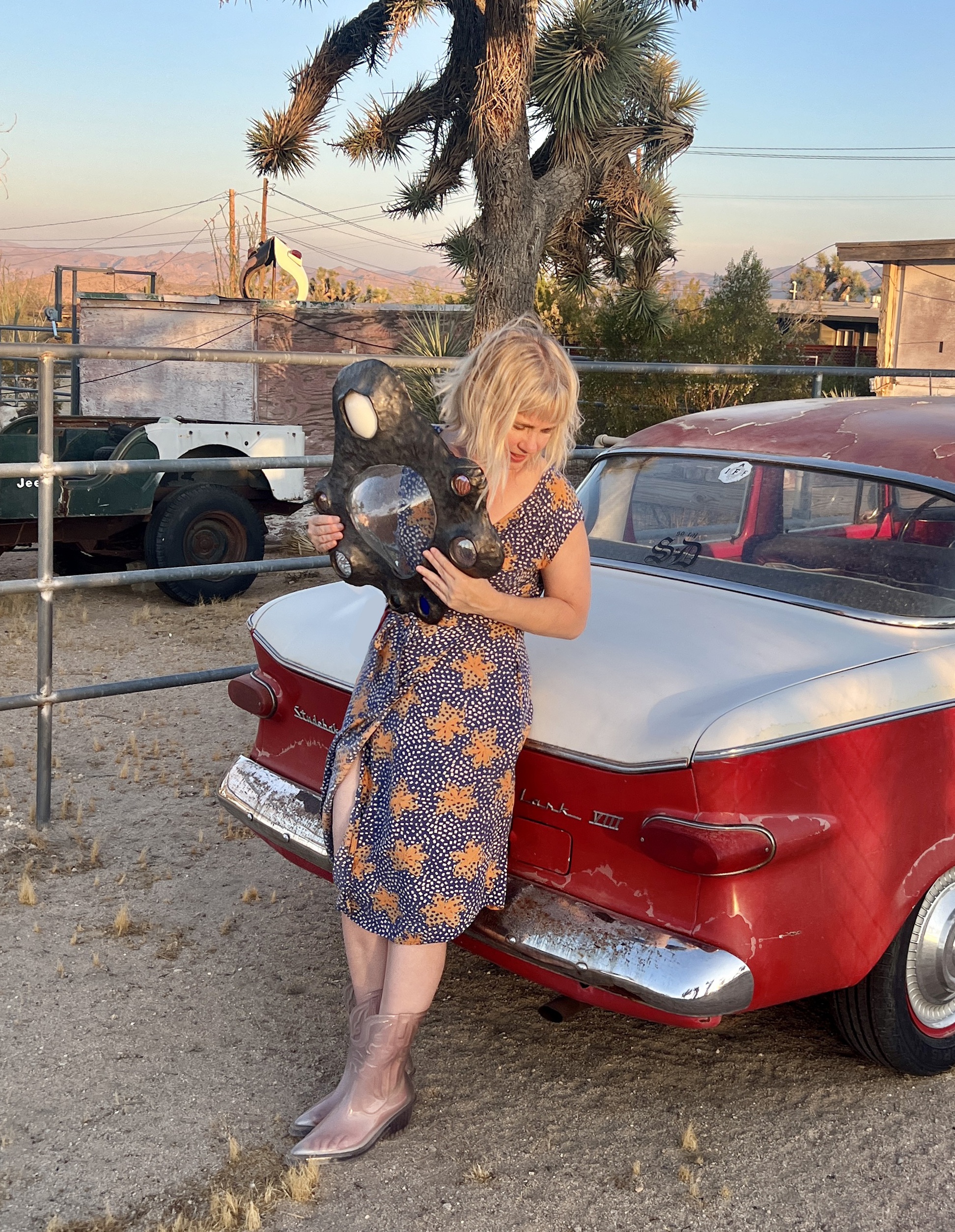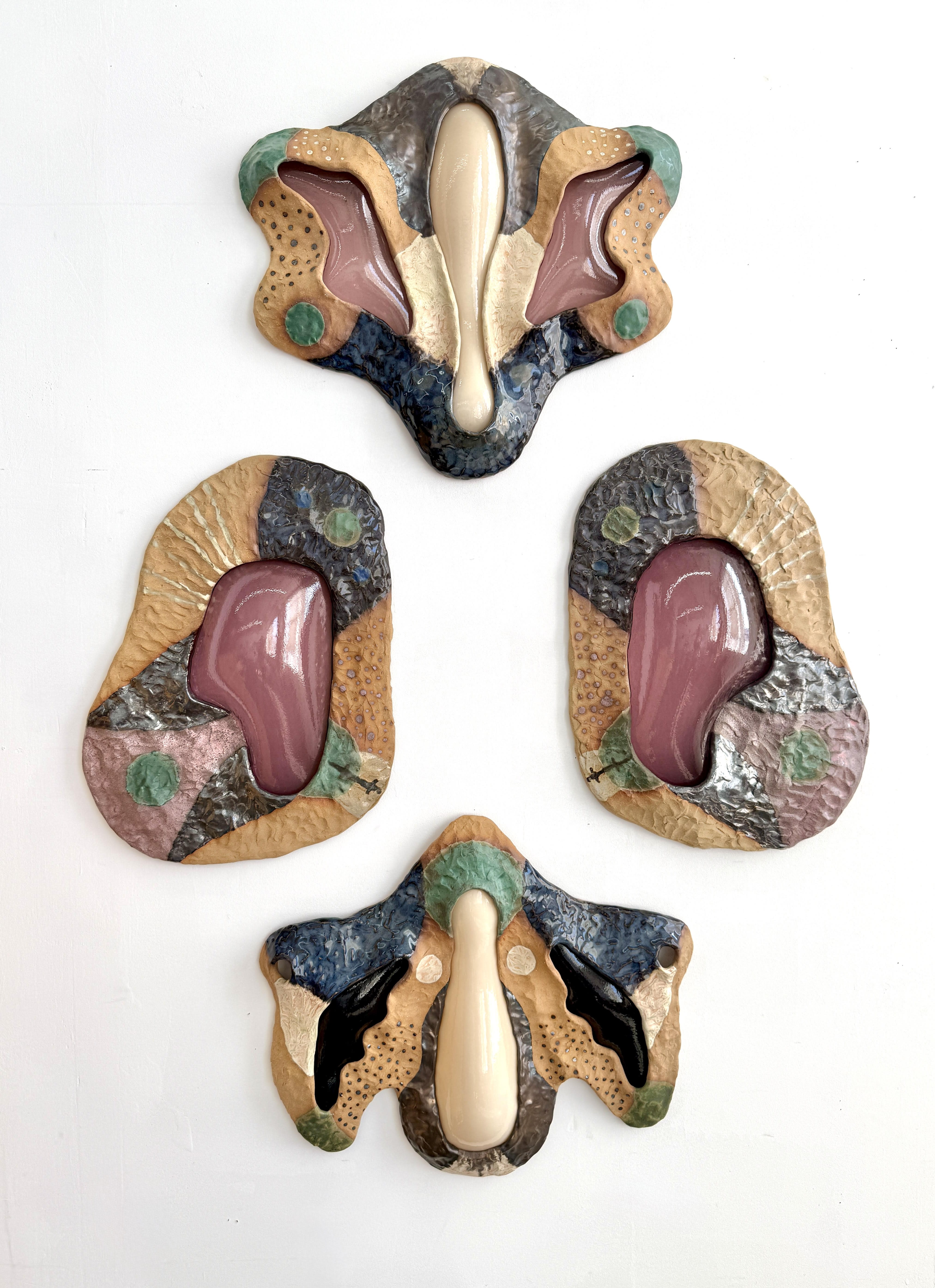
Kelly Witmer surrounded by her artworks.
Kelly Witmer is a multidisciplinary artist whose practice explores the boundaries of material such as ceramic, glass, and metal. We recently interviewed Witmer to discuss her artistic process, which invloves experimentation and pushing materials beyond their limits, producing unexpected results. Her work is currently on view at Abigail Ogilvy Gallery, Los Angeles in "Game Time" through August 2, 2025.
Abigail Ogilvy Gallery: How did you become an artist?
Kelly Witmer: Born this way! I was always drawing, painting and making things as a kid, and an artist was what I wanted to “be”. My choice of mediums and subject matter have changed throughout the years however. I was a photography major in art school, with a lot of crossover into printmaking. My work was always process-driven, with experimentation playing a big role.

Artist Kelly Witmer holding an artwork.
AOG: How do you hope viewers will interpret your work? What feelings do you hope
they experience?
KW: Since most of my work is abstract, it’s very open to the viewer’s interpretation. I welcome the fact that everyone will have their own personal experience, and see different things. That said, I’ve been increasingly interested in sensory perception and how I can shape a viewer’s experience with cross modal interactions. The senses of vision and touch are not isolated - they interact and influence each other. I try to entice with different textures that draw a person in by their desire to touch the work.
AOG: Does your environment influence your practice? For example, does your Joshua
Tree studio inspire different artworks than other studio locations?
KW: Very much! I’m very lucky in that this year I started sharing a studio space in downtown LA, and split my time between the city and the desert. My location decides what medium I will focus on, since my kilns and metal equipment are in Joshua Tree. While in LA I work in painting and textiles, and when in the desert I’m usually focused on ceramic and glass. My paintings inspire my sculptures and vice versa, so I like to stay active in both.

Installation view of Game Time at Abigail Ogilvy Gallery, Los Angeles. Left to right: Thomas Martinez Pilnik, Wilhelm Neusser, Kelly Witmer.
AOG: What does your studio process look like?
KW: It depends where I am. In LA I set up a watercolor station where I’m staying, and sketch or make small paintings on paper in the morning. Then I head to the studio and work larger with oil or acrylics on canvas.
In the desert, I have a usual rotation that goes something like this: building ceramic forms for several days, then a day or two of glazing before they get their first firing. Then I cut sheets of glass to fit the forms and fire them a second time. Sometimes I fire them a third time with the raku process, and often the glass needs another firing as well to get it right.
AOG: You’ve stated that you embrace unexpected results in your works. Do you go into each artwork with an idea of the end result, or is your process more about experimentation?
KW: It’s really a combination. I always start with an idea that I’ve sketched out, and often I cut out a paper pattern. I either use the pattern to cut out a clay slab, or I use it as a guide to coil build. More often than not I make changes along the way, and the sketch or pattern is a jumping off point. I sometimes start with ideas for the glaze, but usually that evolves along the way. Sometimes I’ll take a photo of a form with my iPad, so that I can draw on top different ideas for glaze designs before I paint them.
I’ve been getting more into painting with glaze, and in a way that almost always yields surprises. It takes a lot of experimentation to figure out how glazes will react with each other, and it’s such a thrill when I get some to melt beautifully.
Then attempting that alchemy with raku takes it to another level. Because the same glazes can have a completely different reaction depending on the flames and oxygen reduction.

Kelly Witmer, Metamorphosis, 2025, Ceramic and Glass, 35 x 55 in.
AOG: How has your practice evolved throughout your career?
KW: I started playing with ceramics twelve years ago, when I randomly ended up with a kiln through a trade. It was many years before I started translating what I was doing in painting into ceramic and glass. But once I did, I really felt at home with my work.
AOG: Your works explore a range of media. What inspires your use of material? Is materiality important to your work and process? Any favorite materials?
KW: I’m not sure why, but I seem to be drawn to working with unforgiving materials. Ceramic is tough, and glass is even worse. I’m often getting my heart broken by something breaking in the kiln after putting a lot of work into it. But by the same token, when I open the kiln and got what I hoped for, or even better - that’s just gold. I really love so many different mediums, it’s hard to pick a favorite. Even in the realm of painting, it’s a tie between oil and watercolor.
AOG: Are there any materials that you have not worked with before that you would like to explore?
KW: I’m pretty curious about 3D printing technology, and how it can be used with classic mediums like glass or bronze casting. I’m also really drawn to textiles, but it’s not something I’ve had the chance to really dive into.
AOG: Are there any artists that inspire you?
KW: SO many! Kiki Smith, Louise Bourgeois, Lee Bontecou, Meret Oppenheim, Eva Hesse, Christina Ramberg…. There’s some guys, too, I just can’t recall their names at the moment.
AOG: What advice do you have for artists just starting out?
KW: Community is really important - seek out other artists you respect and can relate to. Do everything you can to keep rejection from getting to you.
Blog written by Emma Lenning.

Add a comment